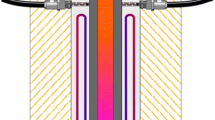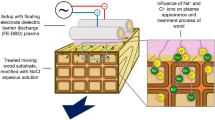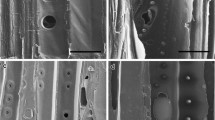Abstract
The effect of O2 addition in the gas feed of an open-to-air N2–O2 dielectric barrier discharge (DBD) on the surface modification of sugar maple hardwood samples is reported. After treatment by N2–O2 plasma, an increase of the contact angle with water and a decrease of the contact angle with diiodomethane was observed. X-ray photoelectron spectroscopy and Fourier-transform infra-red analyses further reveal a decrease of the O/C as well as increase of the C=O peak and surface aromaticity. When O2 is added to the nominally pure N2 DBD, the discharge transits from a homogeneous regime to a filamentary regime with increased dissipated power and neutral gas temperature. As a result, surface modification by N2–O2 plasmas becomes similar to those occurring under a low-temperature heat treatment of wood surfaces. In such conditions, a mechanism involving the thermally-activated deacetylation and depolymerisation of hemicelluloses and cross-linking between lignin and furfural and hydroxylmethylfurfural, leading to the increase of wood hydrophobicity is proposed.










Similar content being viewed by others
References
Acda MN, Devera EE, Cabangon RJ, Ramos HJ (2011) Effects of plasma modification on adhesion properties of wood. Int J Adhes Adhes. doi:10.1016/j.ijadhadh.2011.10.003
Avramidis G, Hauswald E, Lyapin A, Militz H, Viöl W, Wolkenhauer A (2009) Plasma treatment of wood and wood-based materials to generate hydrophilic or hydrophobic surface characteristics. Wood Mater Sci Eng 4:52–60. doi:10.1080/17480270903281642
Brandenburg R, Maiorov VA, Golubovskii YB, Wagner HE, Behnke J, Behnke JF (2005) Diffuse barrier discharges in nitrogen with small admixtures of oxygen: discharge mechanism and transition to the filamentary regime. J Phys D Appl Phys 38:2187–2197. doi:10.1088/0022-3727/38/13/017
Bryne L, Lausmaa J, Ernstsson M, Englund F, Walinder M (2010) Ageing of modified wood. Part 2: determination of surface composition of acylated, furfurylated, and thermally modified wood by XPS and ToF-SIMS. Holzforschung 64:305–313
Carlsson CMG, Ström G (1991) Reduction and oxidation of cellulose surfaces by means of cold plasma. Langmuir 7:2492–2497
Christiansen AW (1990) How overdrying wood reduces its bonding to phenol–formaldehyde adhesives: a critical review of the literature. Part I. Physical responses. Wood Fiber Sci 22:441–459
Donnelly VM, Malyshev MV (2000) Diagnostics of inductively coupled chlorine plasmas: measurements of the neutral gas temperature. Appl Phys Lett 77:2467. doi:10.1063/1.1318727
Dorris GM, Gray DG (1978) The surface analysis of paper and wood fibres by ESCA (I). Application to cellulose and lignin. Cellul Chem Technol 12:9–23
Eliasson B, Hirth M, Kogelschatz U (1987) Ozone synthesis from oxygen in dielectric barrier discharges. J Phys D Appl Phys 20:1421
Esteves B, Pereira H (2008) Wood modification by heat treatment: a review. BioResources 4:370–404
Gérardin P, Petrič M, Petrissans M, Lambert J, Ehrhrardt JJ (2007) Evolution of wood surface free energy after heat treatment. Polym Degrad Stab 92:653–657. doi:10.1016/j.polymdegradstab.2007.01.016
Gherardi N, Gouda G, Gat E, Ricard A, Massines F (2000) Transition from glow silent discharge to micro-discharges in nitrogen gases. Plasma Sources Sci Technol 9:340–346
Gindl M, Reiterer A, Sinn G, Stanzl-Tschegg SE (2004) Effects of surface ageing on wettability, surface chemistry, and adhesion of wood. Holz als Roh-und Werkstoff 62:273–280. doi:10.1007/s00107-004-0471-4
Hakkou M, Pétrissans M, Zoulalian A, Gérardin P (2005) Investigation of wood wettability changes during heat treatment on the basis of chemical analysis. Polym Degrad Stab 89:1–5. doi:10.1016/j.polymdegradstab.2004.10.017
Inari GN, Petrissans M, Lambert J, Ehrhardt JJ, Gérardin P (2006) XPS characterization of wood chemical composition after heat-treatment surface and interface analysis 38:1336–1342. doi:10.1002/sia.2455
Jean-Michel Hardy LV, Vlad M, Stafford L, Riedl B (2015a) Extractive influence in Black Spruce wood surface modification by cold atmospheric plasma. Surf Innov
Jean-Michel Hardy LV, Vlad M, Stafford L, Riedl B (2015b) Surface free radicals detection using molecular scavenging method on Black Spruce wood treated with cold, atmospheric-pressure plasmas. Appl Surf Sci
Kocaefe D, Poncsak S, Doré G, Younsi R (2008) Effect of heat treatment on the wettability of white ash and soft maple by water. Holz als Roh-und Werkstoff 66:355–361. doi:10.1007/s00107-008-0233-9
Kossyi IA, Kostinsky AY, Matveyev AA, Silakov VP (1992) Kinetic scheme of the non-equilibrium discharge in nitrogen–oxygen mixtures. Plasma Sources Sci Technol 1:207–220
Naudé N, Cambronne JP, Gherardi N, Massines F (2005) Electrical model and analysis of the transition from an atmospheric pressure Townsend discharge to a filamentary discharge. J Phys D Appl Phys 38:530–538. doi:10.1088/0022-3727/38/4/004
Nussbaum R (1999) Natural surface inactivation of Scots pine and Norway spruce evaluated by contact angle measurements. Holz als Roh-und Werkstoff 57:419–424
Pandey K (1999) A study of chemical structure of soft and hardwood and wood polymers by FTIR spectroscopy. J Appl Polym Sci 71:1969–1975
Podgorski L, Roux M (1999) Wood modification to improve the durability of coatings. Surf Coat Int 12:590–596
Prégent J, Vandsburger L, Blanchard V, Blanchet P, Riedl B, Sarkissian A, Stafford L (2014) Determination of active species in the modification of hardwood samples in the flowing afterglow of N2 dielectric barrier discharges open to ambient air. Cellulose 22:811–827. doi:10.1007/s10570-014-0496-8
Rehn P, Viöl W (2003) Dielectric barrier discharge treatments at atmospheric pressure for wood surface modification. Holz als Roh-und Werkstoff 61:145–150. doi:10.1007/s00107-003-0369-6
Riedl B, Angel C, Prégent J, Blanchet P, Stafford L (2013) Wood surface modification by atmospheric-pressure plasma and effect on waterbone coating adhesion. Lignocellulose 2:292–306
Staack D, Farouk B, Gutsol AF, Fridman AA (2006) Spectroscopic studies and rotational and vibrational temperature measurements of atmospheric pressure normal glow plasma discharges in air. Plasma Sources Sci Technol 15:818
Stevanovic T, Perrin D (2009) Chimie du bois. Presses polytechniques et universitaires romandes. CH-1015 Lausanne
Tjeerdsma B, Boonstra M, Pizzi A, Tekely P, Militz H (1998) Characterisation of thermally modified wood: molecular reasons for wood performance improvement. Holz als Roh-und Werkstoff 56:149–153
Tuong VM, Li J (2011) Changes caused by heat treatment in chemical composition and some physical properties of acacia hybrid sapwood. Holzforschung. doi:10.1515/hf.2010.118
Weiland J-J, Guyonnet R (2003) Study of chemical modifications and fungi degradation of thermally modified wood using DRIFT spectroscopy. Holz als Roh-und Werkstoff 61:216–220
Wolkenhauer A, Avramidis G, Hauswald E, Militz H, Viöl W (2009) Sanding vs. plasma treatment of aged wood: a comparison with respect to surface energy. Int J Adhes Adhes 29:18–22. doi:10.1016/j.ijadhadh.2007.11.001
Acknowledgments
This research was supported by the Fonds de Recherche du Québec-Nature et Technologie (FQRNT) and by the Conseil de Recherches en Sciences Naturelles et Génie (CRSNG) of Canada.
Author information
Authors and Affiliations
Corresponding author
Rights and permissions
About this article
Cite this article
Prégent, J., Vandsburger, L., Blanchard, V. et al. Modification of hardwood samples in the flowing afterglow of N2–O2 dielectric barrier discharges open to ambient air. Cellulose 22, 3397–3408 (2015). https://doi.org/10.1007/s10570-015-0736-6
Received:
Accepted:
Published:
Issue Date:
DOI: https://doi.org/10.1007/s10570-015-0736-6




